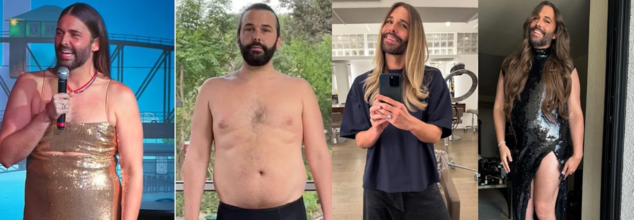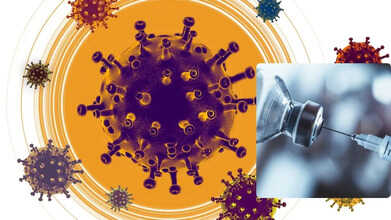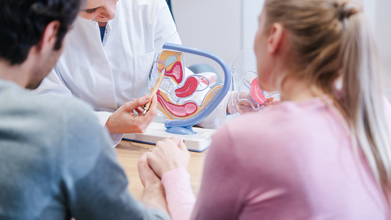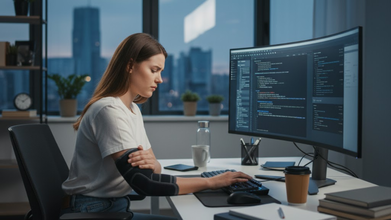- Health Conditions A-Z
- Health & Wellness
- Nutrition
- Fitness
- Health News
- Ayurveda
- Videos
- Medicine A-Z
- Parenting
- Web Stories
‘Queer Eye’ Star Jonathan Van Ness Shows Off Body After 66-Pound Weight Loss- Here’s EXACTLY How He Did It

Image Credit: Instagram/ @jvn
Jonathan Van Ness, the star is best known for his charming on-screen presence on Netflix's 'Queer Eye', has shocked fans with a drastic new look. The 37-year-old recently went on social media to announce he has lost 66 pounds, posting before-and-after photos highlighting his impressive weight loss. Though his journey involved the use of GLP-1 medications, Van Ness also made considerable changes to his lifestyle in order to reach his outcomes.
Van Ness, who has always been open about his body image and mental health struggles, posted his weight loss progress through Instagram Stories. The comparison pictures showed an older picture of his with more of a fuller build next to his current, thinner version of himself. The overlay caption boasted, "Lost 66 pounds!" and was accompanied by the MyFitnessPal logo, insinuating that the use of dietary tracking helped in his makeover.
His honest disclosure immediately fueled discussions, not only on his remarkable weight loss, but also on the regimen he used to get there. One month ago, Van Ness had also quelled rumors, confessing in a TikTok video that he was taking an GLP-1 medication—one of the most buzzed-about weight-loss drugs in recent years.
Van Ness confirmed that he had been prescribed a GLP-1 drug after a consultation with his physician. GLP-1, or glucagon-like peptide-1, is a hormone that regulates blood glucose and hunger. Originally intended for the treatment of Type 2 diabetes, such drugs—such as brand names Ozempic, Wegovy, and Mounjaro—have become trendy among celebrities and the general public for their weight-reducing attributes.
"I've lost and gained weight many times quite publicly, but this time, I required a little bit of additional assistance," Van Ness described, pointing out that his most recent weight gain had been motivated by private personal struggles in the last couple of years. He acknowledged that binge-eating disorder was the central reason behind his weight changes, causing him to experience compulsive eating and guilt.
After attempting a pill form of the medication to no avail, Van Ness moved to an injectable GLP-1 in September 2023. The effect was near-instant. "For the first time ever in my life, I had control over what I ate," he explained, noting the medication has been "massively helpful."
Lifestyle Changes That Made the Difference
Although GLP-1 drugs were part of his change, Van Ness stressed that his weight loss was not only because of the medication. He consciously and sustainably changed his lifestyle so that he would take back control of his well-being.
"I want to mention GLP-1s have been a huge help, but I have also made huge other changes," he said in a social media post. These included:
Healthier Diet: Van Ness overhauled his diet, adopting healthier and more balanced meals.
Reducing Alcohol Consumption: Reducing alcohol consumption was an important factor in enhancing his physical as well as mental health.
Adopting Group Fitness: He emphasized that group Pilates had been the most important modification in his process, enhancing his overall mental and physical health.
"My mental state and overall mood is a different world since last year, and the most significant change was group fitness," he added.
Psychological Impact of Weight Loss and Body Image
Van Ness has been a long-time advocate for mental health awareness, frequently writing about the overlap between body image and emotional health. His recent weight gain, he conceded, had left him feeling "depressed and out of control." He credits medication, but also therapy, exercise, and self-care, with helping him find balance again.
His tale emphasizes a significant discussion regarding weight loss and the emotional price it extracts. Most people struggling with weight issues go through phases of bingeing, self-criticism, and anxiety. Van Ness' honesty regarding his experience motivates others to reach out and find various methods that suit them.
Are GLP-1 Medications a Growing Trend in Hollywood?
Van Ness is not the first public figure to speak about taking GLP-1 medications for weight loss. Over the past few years, a number of celebrities have admitted to taking the drugs.
Whoopi Goldberg has revealed that she lost considerable weight after taking Mounjaro, a GLP-1 drug taken for Type 2 diabetes.
Oprah Winfrey has talked about taking a GLP-1 agonist, although she has not revealed which exact drug.
Kelly Clarkson also revealed taking a weight-loss drug, though she claimed it was not Ozempic but did not provide more information.
The increasing discussion of these drugs has led to arguments about their availability, long-term health impacts, and ethics. Though they have been a miracle for those with weight-related health conditions, there is still fear of their overuse and social pressure to achieve specific body ideals.
With all the ongoing talk about GLP-1 meds, Van Ness' openness reminds us that weight loss isn't simply numbers on a scale but about being better, whole, and complete.
Is The ‘Frankenstein’ COVID Variant The Most Vaccine-Resistant Strain Yet?

Credits: CANVA
The Stratus strain, also known as the ‘Frankenstein’ variant, belongs to the SARS-CoV-2 XFG and XFG.3 lineages and has been spreading swiftly across the United Kingdom, with evidence suggesting it is also circulating globally. According to recent data from the UK Health Security Agency (UKHSA), these variants now account for nearly 30 percent of all COVID-19 cases in England, with XFG.3 emerging as the most dominant strain.
In recent weeks, medical experts have voiced concerns that the Stratus variant might have the ability to partially evade immunity built through vaccination, potentially increasing infection risks across all age groups.
What Sets the Stratus or ‘Frankenstein’ Variant Apart?
One of the unusual symptoms linked to this strain is a hoarse or raspy voice, which doctors say was rarely reported with previous variants. “Unlike earlier strains, Stratus carries specific mutations in its spike protein that may allow it to slip past antibodies formed through prior infection or vaccination,” explained Dr. Kaywaan Khan, a Harley Street general practitioner and founder of the Hannah London Clinic.
Is the Stratus Variant More Transmissible?
The XFG or Stratus strain is a member of the Omicron family and is a hybrid of two subvariants, LF.7 and LP.8.1.2. This combination of genetic material helps the virus attach more tightly to human cells, making it potentially more contagious. Like other variants, it also contains several mutations that may enhance its ability to evade antibodies produced either through infection or vaccination.
Could The ‘Frankenstein’ Variant Be The Most Vaccine-Resistant?
Early reports from health authorities suggest that existing COVID-19 vaccines still provide a degree of protection against the Stratus variant. Vaccines designed for earlier strains continue to reduce the risk of severe illness and hospitalization across multiple variants, and experts remain cautiously hopeful that they will do the same against Stratus. However, studies are ongoing to determine how much protection current vaccines actually provide against this specific strain.
As the situation develops, public health recommendations may change. Officials are urging people to follow reliable updates and continue to follow safety advice. Vaccination appointments remain widely available in the UK, and eligible individuals are encouraged to receive their doses or boosters as recommended.
What Are the Symptoms of Stratus?
The most common symptom so far appears to be a sore throat, though overall, the symptoms are similar to those caused by other COVID-19 variants. People infected with Stratus may experience:
- Fever
- Fatigue
- Cough
- Sneezing
- Runny or congested nose
- Nausea, vomiting, or diarrhea
So far, XFG has not been linked to more severe illness compared to previous variants, and hospitalization rates have not shown a sharp increase, which is reassuring.
Why The Stratus Variant Still Deserves Attention
Although it does not appear to cause more severe disease, the Stratus variant is a reminder that COVID-19 continues to evolve. Vaccines remain the strongest line of defense, and researchers are continuing to study how well they perform against this strain. Staying informed through credible sources and following updated health guidance can help limit the spread and keep communities safer.
3 Fertility Truths Every Woman Should Know, According To A Gynecologists

(Credit-Canva)
Infertility impacts millions across the globe, touching both men and women alike. According to the World Health Organization, around 17.5% of the global population, roughly one in six people, experience fertility challenges. This condition can significantly reduce or even prevent natural conception.
Yet, despite its prevalence, infertility remains clouded by myths and misconceptions, many of which unfairly place the blame solely on women. Seeking to debunk these long-held beliefs, Dr. Holly Miller, an American Board-certified obstetrician and gynecologist, took to Instagram to share three important truths every woman should know about fertility.
3 Truths About Fertility Women Should Know
With the help of modern medicine and medical interventions like IVF, fertility treatment can help people boost their chances of reproducing.
Infertility Isn't Just a Woman's Issue
It’s important to understand that infertility affects both partners — it’s not solely a woman’s issue. Blaming only the woman is both unfair and inaccurate. In fact, experts find that the causes of infertility are almost evenly split between men and women.
Roughly one-third of infertility cases are linked to the woman, another third to the man, and the remaining third result from issues affecting both partners — or from causes that doctors are unable to clearly identify.
To identify the cause of infertility, both partners should undergo testing simultaneously. For men, a semen analysis — a quick and straightforward test — is often the easiest and most informative first step.
The "Wait One Year" Rule Changes with Age
Most couples automatically try to conceive for a full 12 months before they think about seeing a fertility doctor. However, the doctor emphasizes that the woman's age is the single most important factor that affects the chances of successful treatment.
If you are under 35 years old: You can safely try for a full 12 months of regular, unprotected sex before seeking a specialist.
If you are 35 or older: You should contact a specialist after only 6 months of trying without success.
If you are 40 or older: You need to see a specialist right away—as quickly as you possibly can.
The doctor explains that after age 35, the woman's egg supply starts to decline more quickly. Time is essential, so couples should strongly ask their doctors for an early referral.
"Unexplained Infertility" Often Means "Undiagnosed Problem"
When a couple is diagnosed with "unexplained infertility," which happens in about 10% to 20% of cases, it means the basic first tests did not find a clear reason. This can be upsetting, but it does not mean you can never have children. In the doctor's experience, the term "unexplained" often means there are hidden problems, such as:
- Small issues with the male partner's sperm that were missed by the basic tests.
- A hidden condition called Endometriosis, which can only be confirmed by a surgical procedure.
- Not having sexual intercourse at the best time or not often enough.
Hyderabad Neurologist Shares Case Of 25-Year-Old Software Engineer Diagnosed With ‘Tennis Elbow’ Caused by Computer Overuse

(Credit-Canva)
In today's corporate world, desk jobs have become the order of the day and so are the health problems associated with them. Endless typing, long hours of sitting, and poor posture are silently taking their toll on young professionals who spend most of their day glued to screens. Many don't realize that their daily work habits could trigger unexpected medical conditions.
Such a growing concern was once highlighted by Hyderabad-based neurologist Dr Sudhir Kumar, who recently shared a case on X. He wrote about one such case of Riya (name changed), a 25-year-old software engineer who developed a sharp, burning pain in her elbow-a pain which began as a minor ache while typing and gradually became so severe that even lifting a teacup felt unbearable.
What was the cause of the sharp elbow pain that Riya experienced?
Riya tried everything she could think of: Rest, pain relief balms, painkillers, even switching hands while using her computer, but the pain refused to fade. When she finally decided to visit the doctor, her symptoms immediately pointed to something unexpected: Tennis elbow. The diagnosis came as a surprise, considering she had never even held a tennis racket. On examination, Dr Sudhir Kumar found the tell-tale signs of the condition, medically known as lateral epicondylitis — tenderness along the outer elbow and pain when she tried to extend her wrist. He explained that the culprit wasn’t a sport, but repetitive strain from long hours at the computer — a problem increasingly common among desk workers.
What is Tennis Elbow?
The Mayo Clinic describes tennis elbow, medically termed lateral epicondylitis, as a painful condition resulting from the overuse of muscles and tendons in the forearm. It develops where these tissues are repeatedly strained by similar wrist and arm movements, leading to tiny tears and inflammation near the elbow.
The name is misleading, and you don't have to be an athlete to get tennis elbow. As a matter of fact, most people who develop it never have used a racket. It's common for the condition to strike people in jobs that require repetitive motions: plumbers, carpenters, painters, butchers, and yes, office workers who spend hours typing or using a mouse.
The pain generally arises on the outside of the elbow, precisely at that bony prominence to which the muscles of the forearm attach. For some, the discomfort may extend into the forearm or even the wrist, making most activities quite arduous.
How Can Tennis Elbow Be Treated?
Once the diagnosis was confirmed, Dr Sudhir Kumar focused on addressing the underlying cause — repetitive stress and poor workstation ergonomics. The holistic treatment for Riya included the following:
- Avoided repetitive activities that triggered her pain.
- Adjusting the computer setup and improving posture.
- Establish a physiotherapy regimen to stretch, strengthen, and gradually build muscle endurance.
- A short course of anti-inflammatory medication
Employing a counterforce brace-a tennis elbow strap-to reduce strain in daily activities. By her six-week follow-up, Riya’s pain had completely resolved. Her grip strength was back, and she could type, lift, and exercise without discomfort. Three months later, she was symptom-free — and far more aware of how small ergonomic changes can make a big difference.
© 2024 Bennett, Coleman & Company Limited

